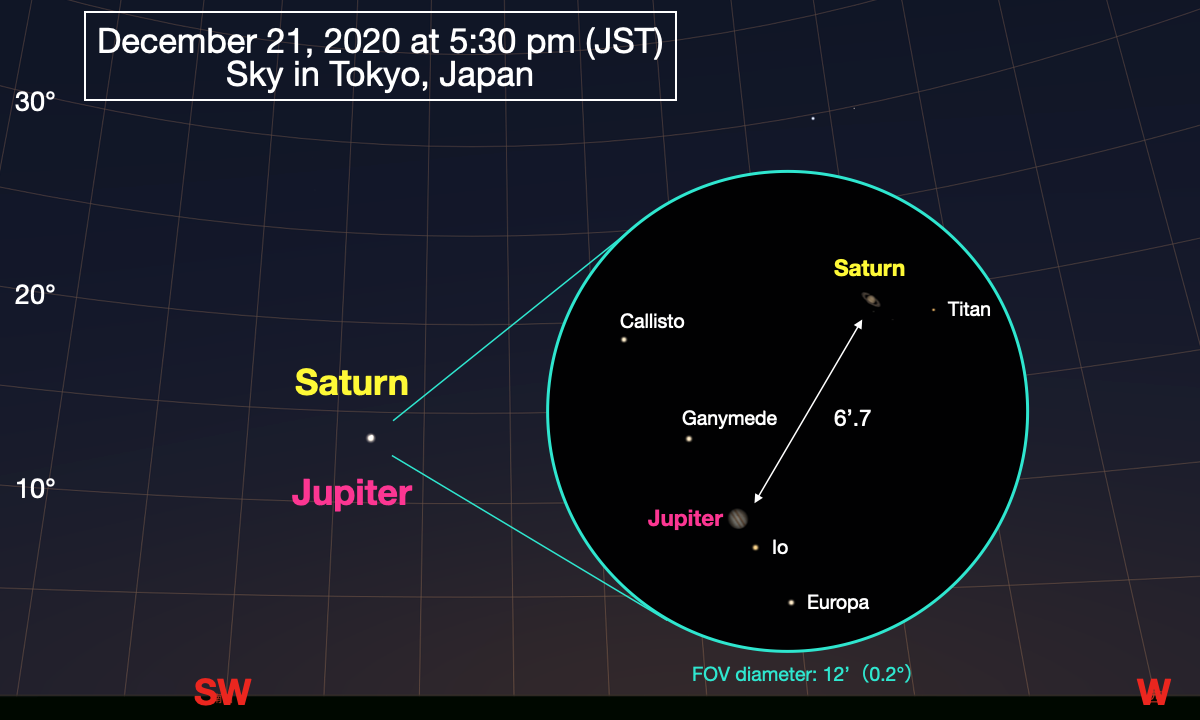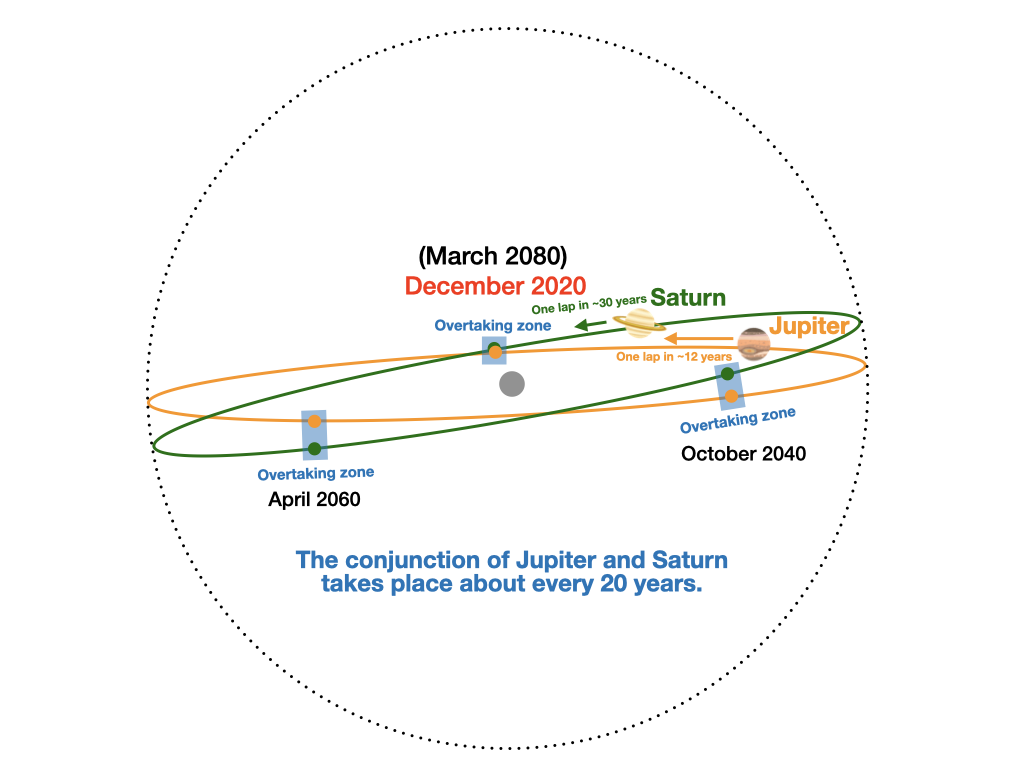
-- This image is made using Stellarium. --
Extra-close encounter of Jupiter and Saturn
Extra-close encounter of Jupiter and Saturn(Note 1) will occur on December 21 (Universal Time) of this year (2020). It is the first time in about 400 years since 1623 that Jupiter and Saturn will be such extremely close.(Note 2) They will be the closest around 18 o'clock on December 21 UTC.(Note 3)
This extra-close encounter will be able to observe in the evening (shortly after sunset) around December 21. Look at low southwestern sky. How can you see Jupiter and Saturn? Do they look like one star, or two stars? It is a celestial phenomenon that no one living now has ever seen. Watch the phenomenon with your eyes.
You can enjoy Jupiter and Saturn at the same time by observing with a telescope.(Note 4) If you have a viewing party at a public observatory or science museum near you, it's a good idea to attend. As the number of astronomical facilities that hold internet live is increasing, it has become possible to enjoy the encounter online.
Continue observing Jupiter and Saturn from the beginning of December and post your results in the "I saw" web-form. You may be excited to see the two planets approaching day by day. Then, as a happy result, you will not have to worry about missing the positions of Jupiter and Saturn on the upcoming day of extra-close encounter!
(Note 1) An astronomical phenomenon in which two celestial bodies (for example, Moon and Mars, Venus and Antares, Jupiter and Saturn, etc.) appear close to each other (the angular distance becomes smaller) is called "appulse". Unlike the approach (in the sense that it approaches the Earth in terms of distance) used in terms such as close approaches of Mars, it is not a phenomenon in which the distance between celestial bodies becomes smaller. In this project, an appulse with an angular distance of 10 minutes or less is called "extra-close encounter".
(Note 2) Jupiter and Saturn were not so apart from the Sun during the "extra-close" encounter in 1623, and may have been difficult to see them with the naked eye (except some areas near the equator). Before 1623, the "extra-close" encounter occurred in 1226 followed by 1563. At the "extra-close" encounter in 1226, the angular separation between Jupiter and Saturn became about 2 arcminutes at the closest.
(Note 3) The least angular distance is about 6 arc minutes (0.1 degrees).
(Note 4) Jupiter and Saturn can be seen in the same field of view from December 19th to 24th with a viewing angle of 20 minutes or more (the recommended magnification of the telescope is 100-150 or less).
The close encounter of Jupiter and Saturn occurs about every 20 years, and the next “extra-” close encounter will occur about 59 years later!
Jupiter takes about 12 years, and Saturn takes about 30 years to orbit the Sun.(Note 5) Jupiter orbits the Sun in shorter period than Saturn, so if you see them from the Sun, Jupiter may appear to be catching up and overtaking Saturn (when overtaking, the two planets appear in the same direction. It is called a "conjunction"). The conjunction of Jupiter and Saturn takes place about every 20 years. When viewed from the earth(Note 6), Jupiter and Saturn still appear to approach each other every 20 years, which is almost the same as the period of the conjunction of Jupiter and Saturn, even though the viewing position is different from that when viewed from the Sun.

-- The orbital inclinations of Jupiter and Saturn are drawn exaggeratedly for the explanation. --
Why is this "extra-close” encounter of Jupiter and Saturn a rare phenomenon? The apparent orbits of Jupiter and Saturn when viewed from the Earth are not in the same plane but intersect at a slight angle.(Note 7) Jupiter and Saturn encounter about every 20 years, but the position of encounter is different each time. This year’s encounter occurs where the orbits of Jupiter and Saturn are very close together.
When they become closest on December 22, it will be an "extra-close" encounter, with their angular distance of about 6 arcmin (about one fifth of the apparent size of the full moon), which is the first time in 397 years since July 17, 1623. Furthermore, the next "extra-close" encounter will occur on March 15, 2080, about 59 years later, so an “extra-close” encounter is a rare event that can be seen or never seen once in a lifetime. The table below shows the angular distances at the time of close encounters from 1901 to 2100. Since 1901, it can be seen that the angular distances at the time of the close encounters become small about every 60 years, but they are not always "extra-close" encounters.
| Date | Angular distance between Jupiter and Saturn at the minimum |
Remarks |
|---|---|---|
| 1901 Nov. 29 | 0° 26' | very close |
| 1921 Sep. 10 | 0° 57' | |
| 1940 Aug. 7 | 1° 11' | |
| 1940 Oct. 20 | 1° 14' | Both Jupiter and Saturn are in retrograde motion |
| 1941 Feb. 15 | 1° 17' | |
| 1961 Feb. 19 | 0° 14' | very close |
| 1980 Dec. 31 | 1° 03' | |
| 1981 Mar. 4 | 1° 03' | Both Jupiter and Saturn are in retrograde motion |
| 1981 Jul. 24 | 1° 06' | |
| 2000 May 28 | 1° 09' | |
| 2020 Dec. 22 | 0° 06' | "extra-close” |
| 2040 Oct 31 | 1° 08' | |
| 2060 Apr. 8 | 1° 07' | |
| 2080 Mar. 15 | 0° 06' | "extra-close” |
| 2100 Sep. 19 | 1° 13' |
(Note 5) Eight planets in the Solar System (Mercury, Venus, Earth, Mars, Jupiter, Saturn, Uranus, and Neptune in order of proximity to the Sun) orbit the Sun in the same direction.
(Note 6) The earth moves faster than Jupiter and Saturn, and orbits the Sun in one year. When the Earth overtakes Jupiter or Saturn, it appears that Jupiter or Saturn move backwards (this is called retrograde motion). When viewed from Earth, the period and frequency of encounters of Jupiter and Saturn, and the approach between Jupiter and Saturn are complicated, in part, due to their retrograde motion.
(Note 7) The orbital inclinations of Jupiter and Saturn are about 1.3 degrees and about 2.5 degrees, respectively. Since the direction in which the orbit is tilted (longitude of the ascending node) is also similar, the angular distance between their orbits is no larger than about 1 degree.
(Note 8) The date of the closest approach is when observed from Tokyo (Japan). The numbers in the table are based on the calculation results by StellaNavigator11.
